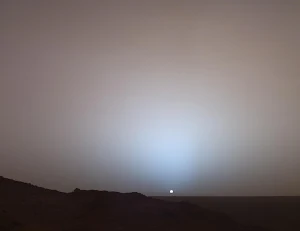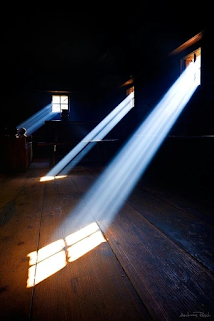Why the sky is blue is one of the most hard-to-answer questions a child can ask, apart from wanting to know why the moon is round and not of any other shape, why not square or a triangle, and what makes the grass green but not purple. Most parents would think their child is asking stupid questions because some things are just the way it is. The moon is round because it has always been like that. The grass is green, the sky is blue, and an apple is red because they are the way they are. However, people tend to forget that our entire physical world is not some voodoo magic but an elegant construct of some definite physical. The sky turns blue by a very subtle mechanism we call Rayleigh scattering. The grass is green because they contain a specific type of pigment called chlorophyll that helps them absorb the energy from sunlight. Children never ask stupid questions. It is the contrary. We grownups do not have the right answers. So rather than discouraging and scolding the little ones for their humble want of knowing, we should encourage our next generation of truth-seekers. Otherwise, we might lose our next genius, for history records that once there was a five-year-old kid who was amazed beyond measure to see a compass needle always point towards the north. That little kid could not help but wonder what magic moved the needle. At that time, no one could have guessed that this kid would one day change our age-old concepts of space, time and reality.
Continuing from where we left off, we have come to know that the daytime sky turns blue due to the Rayleigh scattering of incident sunlight by the nitrogen, oxygen and other gas molecules that compose earth's atmosphere. We have also learned that the same thing gives us our romantic moments of photo-perfect sunsets and golden mornings. Had there been no atmosphere, we would have never known the beauty of sunsets, the elegance of light rays bouncing off individual molecules, lighting up the sky in all sorts of ways. Yet still, there is more to it than meets the eye. Whether looking from the same place or across different geographical locations, we will find that no two consecutive sunsets appear the same. Every single day, there is always some minute, nevertheless noticeable variations; perhaps somewhere it is more red or a little yellow, maybe some orange over there and a white streak of cloud here. Now, let us imagine what it would be on other planets. Take Mars, for example. Firstly the sun would look a little smaller because the red planet lies on average 227 million km away from the sun. Secondly, due to the abundance of fine iron oxide and dust particles in the Martian atmosphere, sunsets and sunrises appear blue. This happens because the Martian dust particles are of the right size to effectively scatter away the red to yellow components of the white sunlight thereby giving a reddish-orange hue to the entire sky while the horizon sun looks blue if we were to directly see it. This overabundance of dust particles makes Martian twilights last longer than their Earthly counterpart as the dust particles floating through the high Martian atmosphere continues to scatter light for a longer time after sundown. Earth's sister planet, Venus, does not have much to offer because the dense sulfur-rich atmosphere blocks almost all of the direct rays of the sun and gives an overall yellowish hue that gradually shifts towards brown as the sun descends below the horizon. All planets come with their unique sunsets. The situation would be more dramatic if we were to imagine ourselves on a planet in a binary or a trinary star system.
 |
There is the sun. It looks small and contrary to our daily experiences, it has taken on a blue appearance instead of our familiar reddish blob.
Image Credits: NASA/JPL/Texas A&M/Cornell |
The enchanting blueness of the firmament had remained a mystery for a long time. Ever since the time of Aristotle, philosophers, scientists and even painters had shared their thoughts. But the real reason or the mechanism remained under the cloak of obscurity until the mid-19th century. Somewhere around the 1860s, the Irish-born physicist John Tyndall, while setting up an experiment to study the effect of the absorption and emission of infrared radiation by various gases, stumbled upon a very interesting phenomenon. In his experiment, Tyndall required a really clean air chamber, free from the slightest impurities and floating agents. The best way to test his air chamber was to bathe it with intense illumination where the floating particles become clearly visible just like the way a beam of sunlight entering a dusty room through a peephole causes the floating dust particle to become visible while the infalling light literally looks like a ray or a beam. Hence the expression a ray of light. After filtering out all the impurities, when Tyndall introduced some smoke into the air chamber, he noticed that while looking sideways, the column of smoke appeared blue, whereas the light coming out of the other end appeared red. From this simple observation, Tyndall hypothesized that the blue colour of the sky must come from a similar phenomenon of light being scattered via particles suspended in high atmospheres. Soon this effect came to be known as the Tyndall effect.
 |
Tyndall effect gives meaning to the phrase, ''a ray of light'' or ''a bema of light''.
Image Credits: Internet |
Tyndall Effect, which is almost similar to Rayleigh scattering, involves the scattering of light by particles in a colloidal solution or in a very fine suspension. A colloid is a type of mixture having microscopic insoluble particles dispersed throughout the solvent medium, which can be air, water or any other liquid solvent. Milk is one example of a colloidal solution, containing fat globules and protein molecules suspended in a liquid phase. Another class of colloids include aerosols, such as the fine mist seen across waterfalls or during early morning, mosquito repellent and perfume sprays, all of which essentially involve minuscule drops of water suspended in air or a gaseous phase. This clears our basic idea of colloids. A suspension on the other hand, is a heterogeneous mixture involving solid particles dispersed in a fluid (liquid or gas) where the particle dimensions are such that they can clump together and undergo sedimentation if left undisturbed for a time. Some flour mixed in a glass of water, mud, fine sand, and chalk powder mixed with water, are good examples of suspension. Smoke is a suspension of solid carbon particles floating in the air. Smoke is also an aerosol and therefore, a colloid. The distinction between a colloid and a suspension is based on the basis of their particle size. Colloidal particles range from 1nm to 1000 nm, while suspensions lie between 1-50 µm.
When an intense beam of white light shines through a colloid such as milk or a suspension of flour in water, both solutions turn blueish when seen from a lateral direction, whereas the transmitted beam on the other end looks red. This happens because the dimensions and geometry of the suspended particles are such that they scatter away the incident light beam through various angles. Due to the strong wavelength dependence for both Rayleigh and Tyndall scattering, blue light is scattered more than red light, thereby turning the solution blue. The Tyndall Effect can be easily demonstrated by mixing some flour or milk in a glass of water and then shining white light upon it. When seen from the side, the solutions will be blue, while the transmitted beam will look towards the reddish part of the spectrum. The Tyndall effect becomes vividly distinct in an aqueous solution of sodium thiosulfate, where the formation of colloidal sulfur turns the solution into a brilliant blue (much like that blue lagoon cocktail), while the transmitted beam on the other end gradually becomes redder and redder. In our daily lives, the exhaust smoke of cars turns blueish due to the Tyndall effect. Another great way to see this Tyndall effect is to turn on a car's headlights on a foggy evening, wherefore the beam will be sharply visible. This same effect adds a blueish tinge to distant mountains and makes a laser beam visible when we turn on our humidifier.
Tyndall effect is a special case of Rayleigh scattering, where the only difference lies in the size of the scattering particles. Rayleigh scattering pertaining to the blue colour of the sky happens from individual nitrogen and gas molecules whose dimensions are much smaller than the wavelength of sunlight. Tyndall effect or Tyndall scattering occurs when the size of the particle becomes almost comparable to the wavelength of light. This is all we need to understand its relation to sunsets. Most articles wrongfully claim that dust and smoke particles can enhance an ordinary sunset into something spectacular, turning it more red and vivid. Some sources even go to the extent of saying that increased air pollution will result in deeply red sunsets. But as per the following National Geographic and Scientific American articles, the actual scenario is far more complex. The amount of light scattered depends mostly on the size of the scattering particles. Scattering from smaller particles such as individual gas atoms or molecules is intensely wavelength dependent, wherefore they behave as Rayleigh scatterers. When the particles get large enough, they lose their wavelength dependence, and unlike the strictly selective nature of Rayleigh or Tyndall scattering, the particles scatter whatever light falls on them. The atmosphere closer to Earth's surface is not clean or pure. It is contaminated by floating dust and pollen grains, droplets of oil, smoke, soot, very fine sand and other aerosols of varying shapes, sizes and scattering power. These impurities, including even the microscopic organisms - certain species of bacteria floating throughout the lower atmosphere can vastly alter the sky colour and at times even dim the brilliance of the shining sun.
Under some very specific scenarios, air pollution can, in fact, to some extent, redden sunsets. But that does not mean prettier sunsets. Certain types of impurities, for example, sulfur particles, when ejected into the atmosphere from blazing volcanoes, add a deep red tinge to the setting/rising sun. If the particles climb higher up into the stratosphere, they will create vibrant afterglows of red, orange and pink that might last for over a month post volcanic activity. But if there happens to be some supervolcano eruption, then the sheer mass of ejected debris, dust and particulates will completely obscure the sun and kick-start a volcanic winter.
From the heart of a densely populated city, sunset colours can vary according to the degree of air pollution and the presence of particulate matter. As already mentioned, too large a particle will not undergo selective scattering, but instead, they will only scatter whatever light falls onto them. During sunsets, the already Rayleigh scattered sunlight will face multiple scattering due to the high concentration of aerosols closer to the earth's surface, which will ultimately lessen (attenuate) the net intensity of the transmitted light. Similarly, the Tyndall effect, contrary to most articles, washes out the true brilliance of sunsets resulting from the selective Rayleigh scattering. Too much pollution can make the daytime sun lose its normal shine. This line of reasoning explains why the sun seems to brighten up and sunsets look scintillating after a short spell of rain which removes all the floating impurities and cleans the air. All in all, air pollution results in duller sunsets. Its true spectacle lies in the Rayleigh scattering occurring in clean to ultra-clean air. Accordingly, some of the spectacular sunsets can only be seen from an aeroplane at a high altitude.
 |
Clouds add an extra oomph to sunsets
Image Credits: Photo by form PxHere |
The last thing we are going to discuss in this article is the colour of the clouds. Clouds are white due to a phenomenon known as Mie scattering. To elude any unwanted confusion, let us recall that the blue colour of the sky comes from Rayleigh scattering by individual gas molecules that are almost 1000 times smaller than the wavelength of sunlight. Tyndall scattering results from material particles ranging from 40-900 nm, which is quite close t the wavelength of visible light. When the size of the particles gets large, the scattering phenomenon calls for a very sophisticated treatment of Maxwell's electromagnetic equations. This rigorous mathematical treatment to characterise the scattering of EM radiations by a homogeneous spherical particle was carried out in 1908 by Gustav Mie. The same calculation was already worked out and published by Ludvig Lorenz as early as 1890. Unfortunately, Lorenz's efforts went unnoticed. However, one year after Mie's publication, Peter Debye independently solved the scattering problem and rederived Lorenz's equations. Thus, Mie's solutions to the scattering problem are also known as the Lorenz-Mie solutions or the Lorenz-Mie-Debye solution describing the scattering of electromagnetic radiations by a microscopic spherical body or of any other geometrical shape.
For the mathematically inclined reader, the Mie solution is not a unique solution but combines a collection of solutions, different formulas and approximating techniques describing the scattering of electromagnetic radiation via larger particles. It is a further generalisation of Lord Rayleigh's scattering theory. Unlike Rayleigh or Tyndall scattering, the Mie scattering is neither selective nor strictly wavelength dependent. While the former pair filters out the higher frequency components from a typical beam of white light, the latter does not choose a particular wavelength but scatters the entire beam either strongly or weakly, depending on its size. As opposed to Rayleigh scattering, which takes place uniformly in all directions, Mie scattering is predominantly forward directed, whence its intensity increases with the increasing size of particles. This explains the almost blinding white glare near the vicinity of the daytime Sun when we are looking directly at it. A simple way to differentiate between Mie scattering and Tyndall scattering is to get hold of a smoker and notice how the smoke rising from the burning cigarette end has a blueish tinge (Tyndall scattering) while the exhaled smoke takes on a whitish appearance (Mie scattering). The colour changes because the size of the smoke particles gets larger. While the smoke is inhaled and kept inside the lungs, on the way in and out, the smoke particles latch onto the water vapour molecules and eventually, they get big enough to undergo Mie scattering.
 |
Typical Indian monsoon clouds carry a huge volume of water and hence appear darker at the base due to the multiple scattering of the infalling sunlight which continually gets redirected and ultimately loses its path inside the cloud system.
Image Credits: Author's Phone |
Clouds are nothing other than water molecules suspended in the air. Being larger than the wavelength of white sunlight, the water vapour molecules undergo Mie scattering sending light in the forward direction. Instead of selective scattering, Mie scattering scatters the total package of the incident light, creating a 'white light in, white light out effect'. The colour of the clouds depends on numerous factors, including the angle of illumination, how much water vapour it contains, geographical locations, amount of air pollution and similar others. A typical column of cumulonimbus cloud, towering over 15 km, can display a wide gradation of colour. The cloud base might look a deeper shade of grey or blueish grey (to be exact), while the upper top layers might be white, depending on the direction of solar illumination. Thicker clouds appear dark grey because of the sheer volume of water it holds. As the sunlight passes from the top of the cloud to the base, it gets repeatedly scattered as it descends down the cloud layers. After a certain point, due to the enormous number of collisions and multiple scattering, the light goes extinct, and clouds become dark. Sometimes clouds might look blue by reflecting the surrounding Rayleigh scattered blue light from the upper atmospheres. During sunrise and sunset, the colour of the clouds comes from a combined effect of Rayleigh and Mie scattering. As the sun hangs low over the horizon, Rayleigh scattering removes the blue wavelengths from the incident sunbeam, turning the clouds red, yellow and orange by virtue of Mie scattering.
 |
Rayleigh and Mie scattering can light up the sky in magical ways
Image Credits: Author's Phone |
Albert Einstein once remarked, ''Subtle is the Lord. Malicious, He is not''. This is not the right place to debate what Einstein meant by His majesty's maliciousness. But coming to the end of this article and from the preceding one, we can sure understand His subtlety. A singular glimpse at the sun does not tell us how that globe of plasma shines by fusing hydrogen nuclei into helium and liberating copious amounts of energy. It does not tell us of the emanating electromagnetic fields that spread outwards throughout the total extent of the spacetime fabric, of photons rushing past at a blistering speed and colliding with the gas molecules and other constituent particles in earth's atmosphere, giving rise to a host of optical phenomena. On our way back home, that scarlet-red western front does not let us feel the swift motion of the earth, bound in a more or less elliptical trajectory around the sun, much like the latter's motion in a similar orbit around the Milky Way, which is itself gravitating towards the Andromeda galaxy. Call it Einstein's Lord or Spinoza's Deus, sive Natura, whoever that might be, who caused the first cause, has concealed themselves from our immediate human perceptions. At the root level, Nature is so complicated, so removed from our familiar experiences, that even the best minds can lose their way in trying to figure out how the world works. So it took almost 2.5 million years since the dawn of the primitive man to finally explain something as simple as a star. This is the true romance of physics.
References:
- https://www.thoughtco.com/why-the-sky-is-blue-experiment-606169
- https://www.edge.org/response-detail/10432
- https://www.theatlantic.com/magazine/archive/1904/01/the-blue-color-of-the-sky/638276/
- Greenler, Robert. Rainbows, Haloes and glories. Cambridge University Press







Comments
Post a Comment